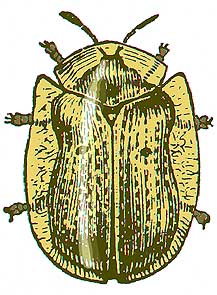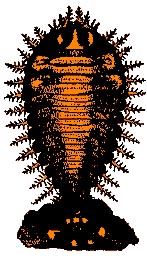
adult; length 5.5-6 mm
BUG OF THE MONTH: September 1994
Golden Tortoise Beetle:
Metriona bicolor, family Chrysomelidae
Copyright © 1994 by Louise Kulzer
This article originally appeared in Scarabogram, Sept. 1994, New Series No. 173, pp. 2-3.
|
|
| Metriona bicolor adult; length 5.5-6 mm |
Few who see the "gold bug" forget it. It is one of the most striking insects in the Puget Sound area. The golden tortoise beetle is a stunning, vibrant metallic gold color. It has a magical quality, not only because of the brilliance of its color, but also because the brilliance isn't permanent. Metriona can alter color within a short time period, turning from brilliant gold to a dull, spotty reddish color. The gold color also fades when the insect dies. What controls the color while the insect is alive is an intriguing question, but one for which I have no answer. [The gold color is caused by a thin layer of moisture between the cuticle and an inner layer of the elytra. Apparently the insect is able to "voluntarily" squeeze this layer, reducing its thickness and eliminating the gold color. This change also occurs involuntarily when the beetle is under moisture stress, and, of course, when it dies. ---editor.]
A bit smaller than the more familiar ladybird beetles, the golden tortoise beetle is configured somewhat like a safari hat with a narrow "shelf" skirting the outside of the wing covers and thorax. This "shelf" causes the resemblance to a tortoise, hence the name. Tortoise beetles are plant eaters, like most Chrysomelids [leaf beetles]. The golden tortoise beetle in particular feeds on morning glory. They reside under the leaf, eating a series of small holes resulting in a characteristic damage pattern (see figure below).
|
|
|
Metriona damage on morning glory |
The larval stage of Metriona is at least as interesting as the adult, though perhaps not as magical. The larvae also feed on the underside of morning glory leaves. When they shed their skin, it remains attached to a prong-like process at the end of the abdomen. Molts are stacked on molts, and are carried around held over the insect's back like a parasol. "Parasol beetles" is indeed another common name for tortoise beetles. When disturbed, the larvae wave the parasol about, no doubt to intimidate or distract potential predators.
Tortoise beetles overwinter as adults. In the spring the adults begin to feed, mate, and lay eggs. The larvae emerge and feed through the summer, and pupate in late summer. Adults reportedly emerge in the early fall, feeding until the morning glory gives up the ghost for the current season, and then hunker down among plant debris for the winter. I've only seen tortoise beetles on morning glory, which, in my opinion, is poetic justice. I wonder, however, if in the spring they might use alternate food plants since it takes a while for morning glory to put out many leaves, concentrating as they do on getting those stems out there. Natural history observations would be welcome, fellow Scarabs. Remember as you pass vacant lots to look for morning glory and holes in leaves. And do take a minute to look underneath.
 |
| Metriona larva |
You may just be rewarded with a glimpse of gold!
References
Barrows, E.M. 1979. Life cycles, mating and color change in tortoise beetles. Coleopterists's Bulletin, vol. 33 no. 1.
Hatch, Melville H. 1971. The Beetles of the Pacific Northwest. Volume 5, p. 238. University of Washington Publications in Biology, vol. 16, University of Washington Press.
Mason, 1929. Entomological News, vol. 40: 52-56.
Riley, E.G. 1986. Review of the tortoise beetle genera of the tribe Cassidini occurring in America north of Mexico. Journal of the New York Entomological Society, 94(1): 98-114. [changes scientific name of species from M.bicolor to Charidotella bicolor. This change does not seem to be widely accepted. It is in 6 scientific papers (3 by Riley himself) but Metriona is still used in 53 out of 70 nontechnical sources.]
This page last updated 16 June, 2005